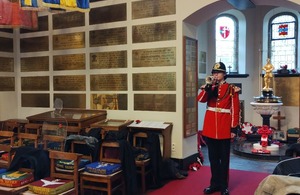Graves of missing Bedfordshire Officers of World War 1 identified in Belgium
The lives of two Second Lieutenants who served in the Bedfordshire Regiment in World War 1 have finally been commemorated. Their identification as officers of the Bedfordshire Regiment was made from their boots, clothing and buttons.

Drummer Jacob Smith sounds Last Post inside St George's Church, Ypres (Crown Copyright)
More than 110 years after their deaths, the lives of two Second Lieutenants who served in the Bedfordshire Regiment in World War 1 have finally been remembered in the presence of their families.
A rededication service, organised by the MOD’s Joint Casualty and Compassionate Centre (JCCC), also known as the ‘MOD War Detectives’, was held at the Commonwealth War Graves Commission’s (CWGC) Railway Dugout (Transport Farm) Cemetery for Second Lieutenant (2Lt) Kellie.

The military party and other invitees at 2Lt Kellie's graveside (Crown Copyright)
Second Lieutenant Esmond Lawrence Kellie was promoted to the rank of Second Lieutenant on 1 January 1915 and transferred to the 1st Bedfordshire Regiment shortly thereafter. On 19 April 1915 he was injured in the thigh whilst defending a trench his battalion had captured at Hill 60, and was killed by a shell whilst being stretchered away from the area. A letter sent home to his parents by Lieutenant-Colonel Griffith DSO described him as a ‘most courageous and useful officer…very popular with all in the regiment’.
Kellie was buried on Hill 60, but his grave was lost in the chaos of war. On or around 5 October 1924 an unknown British Second Lieutenant of the Bedfordshire Regiment was recovered from an unmarked grave at Hill 60 and reburied at Railway Dugouts Burial Ground. The casualty’s partial identification as an officer of the Bedfordshire Regiment was made from the buttons and badges he was wearing.
A similar service was planned for 2Lt Eric Hopkins at CWGC Bedford House Cemetery, but Storm Benjamin meant that this had to be changed for a service of remembrance at St George’s Memorial Church instead.

Wreaths laid near the altar in St George's Church, Ypres (Crown Copyright)
Second Lieutenant Eric Arthur Hopkins originally joined the 2nd Battalion of the Bedfordshire Regiment, arriving in France in October 1914. He was injured later that same month, and on his return to the front he transferred to the 3rd Battalion. At the time of his death he was attached to the 1st Battalion, who were engaged in the struggle for Hill 60 – a small area of slightly raised ground which was a strategic advantage to whichever side held it.
On or around 8 September 1922 an unknown British Officer of the Bedfordshire Regiment was recovered near Hill 60 and reburied at Bedford House cemetery. The casualty’s partial identification as an officer of the Bedfordshires was made from his boots, clothing and buttons. A further 9 soldiers were recovered from the same place at the same time, and three of these were identified as men of the 1st Bedfords who died on 5th May 1915.
JCCC Caseworker, Alexia Clark, said:
I am grateful to the researchers who originally submitted evidence suggesting the location of 2Lt Kellie and 2Lt Hopkins’ grave. In rededicating their graves today, we have reunited their mortal remains with their names, ensuring that their sacrifice will not be forgotten.
The headstones over both graves were replaced by CWGC who will care for them in perpetuity.
Commemorations Case Officer at the CWGC, Dr Daniel Seaton, said:
It is always moving to be able to transfer a name from one of the Commission’s Memorials to the Missing to a named grave in our care. More than a century after their deaths, this has now been possible for Second Lieutenants Kellie and Hopkins, whose final resting places will continue to be tended to by the Commission. Our sincere thanks are owed to the researchers who submitted their identification cases to us, which ultimately led to the rededication ceremonies held today.